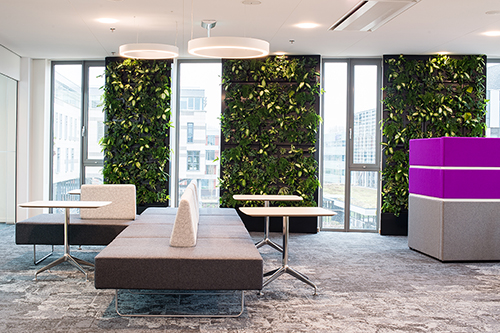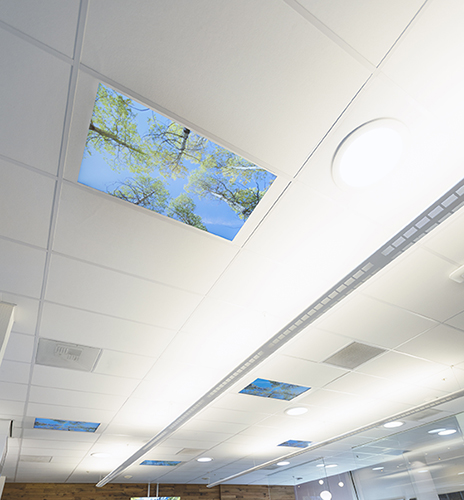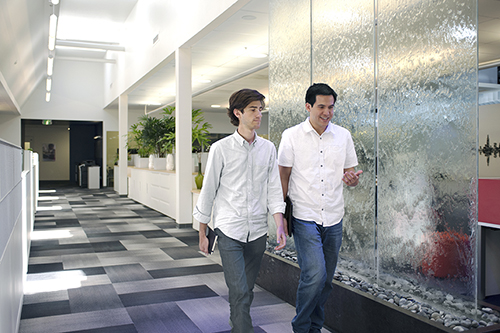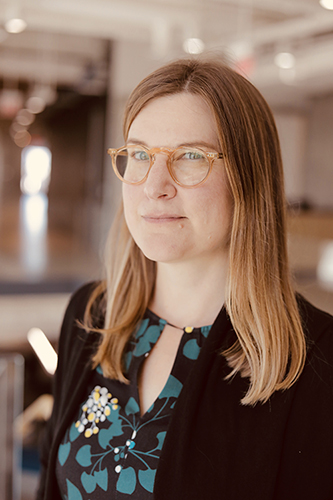The Open Office Gets in Touch with Nature
 Open-plan offices are notorious for crushing productivity, according to a Harvard study Why? Because of distraction from noise — specifically speech. Among the other noises produced in the workplace setting, few things draw human attention more
than the sound of voices. So, in an open office, with no walls and nary an acoustically absorptive surface in sight, every phone conversation, every chat about the weather and every muttered response to a tedious email might as well be shouted through
a megaphone.
Open-plan offices are notorious for crushing productivity, according to a Harvard study Why? Because of distraction from noise — specifically speech. Among the other noises produced in the workplace setting, few things draw human attention more
than the sound of voices. So, in an open office, with no walls and nary an acoustically absorptive surface in sight, every phone conversation, every chat about the weather and every muttered response to a tedious email might as well be shouted through
a megaphone.
To investigate how we can improve the workplace environment in open-plan offices, I recently made the arduous journey to Santa Cruz to visit Plantronics. Plantronics is bringing the California factor to the equation with its Habitat Soundscaping creation.
Now if you aren’t familiar with Santa Cruz, let me give you some keywords: redwoods, ocean, surfing innovation and amazing coffee. So obviously, whatever I write about this visit will be influenced by those factors, along with the gorgeous sunlight pouring through the “sky tubes” installed throughout the Plantronics office, the lush plant-life visible through every window, and numerous cascading waterfalls.
 In research conducted during its own open-office growing pains, the company rediscovered an ancient truth: Humans enjoy the sounds of nature. In fact,
there is new evidence that stress hormones are reduced when we perceive natural sounds around us.
In research conducted during its own open-office growing pains, the company rediscovered an ancient truth: Humans enjoy the sounds of nature. In fact,
there is new evidence that stress hormones are reduced when we perceive natural sounds around us.
And, in what seems a perfect coincidence, surrounded as it is by forests full of babbling brooks and ever-present ocean waves, Plantronics’ search for precisely the right nature sounds to use as a noise buffer revealed that humans respond particularly well to the natural sounds of flowing water. It’s even been known to produce a cognitive boost.
With these ideas in mind, the Habitat Soundscaping solution was built around the soothing delivery of both the auditory and visual elements of flowing water. Because, as I learned during my presentation and tour with Dan Marston, a Product Manager for Habitat Soundscaping, it’s not just the sound of water that is key, but also the visual element of the waterfalls that help complete the cognitive circuit and create a calming environment that also reduces how distracting nearby conversations can be. We hear water, we need to see a likely source of it somewhere in order to relax. So, while the water features themselves aren’t generating much noise, they do serve as a backdrop to sounds piped in via an adaptive network of speakers which actively adjusts output volume according to real-time noise level measurements.
 As the sun shone outside the Plantronics office, we wandered throughout the space, hearing different types of watery landscapes, ranging from
ocean waves to burbling streams to soothing rain. The different options serve a functional purpose as well as an aesthetic one. Different sounds can be selected to match particular teams or tasks, producing energizing sounds to stimulate engagement
on repetitive tasks, for example, or if a very stressful task group needs some soothing. And also, Marston pointed out, certain regional preferences will exist. Seattle definitely won’t want the sounds of rain every day, for example.
As the sun shone outside the Plantronics office, we wandered throughout the space, hearing different types of watery landscapes, ranging from
ocean waves to burbling streams to soothing rain. The different options serve a functional purpose as well as an aesthetic one. Different sounds can be selected to match particular teams or tasks, producing energizing sounds to stimulate engagement
on repetitive tasks, for example, or if a very stressful task group needs some soothing. And also, Marston pointed out, certain regional preferences will exist. Seattle definitely won’t want the sounds of rain every day, for example.
Just a few more human factors to consider when designing a workplace experience. Maybe all the open office needs is more connection with nature. Not just with organic kombucha on tap, but with soundscapes and circadian lighting. Take some notes the next time you’re outdoors, and see what you can bring inside for more human-centric designs.






